Key Points:
- Ring-necked snakes live all throughout the state of North Carolina and are non-venomous.
- The copperhead, cottonmouth, eastern coral snake, pygmy rattlesnake, diamondback rattlesnake, and timber rattlesnake are all venomous snakes that inhabit North Carolina.
- North Carolina has one of the largest varieties of rattlesnakes of any state in the U.S.
North Carolina really has it all. From the stunning Smoky Mountains to miles of oceanfront beaches and plenty of grasslands, marshes, and rivers in between the landscape of North Carolina is very diverse. And because of that it also has a very diverse collection of wildlife that call the state home. For snakes, in particular, North Carolina offers great natural habitats. The hot and humid temperatures throughout the spring and summer keep the snakes very happy too. There are 37 types of snakes in North Carolina including six types of venomous snakes. Let’s dive into some of the most common snakes of North Carolina with pictures so you can identify them!
Common Non-Venomous Snakes in North Carolina
There are a lot of different kinds of NC snakes, so if you’re skittish around snakes you might be scared thinking about how many different kinds of snakes you might see here! But snakes in North Carolina run the gamut from tiny little snakes that are under a foot long to large snakes that look intimidating but really are not going to bother you unless you bother them.
Some of the most interesting and common non-venomous snakes in North Carolina are:
Rat Snake (Pantherophis alleghaniensis)
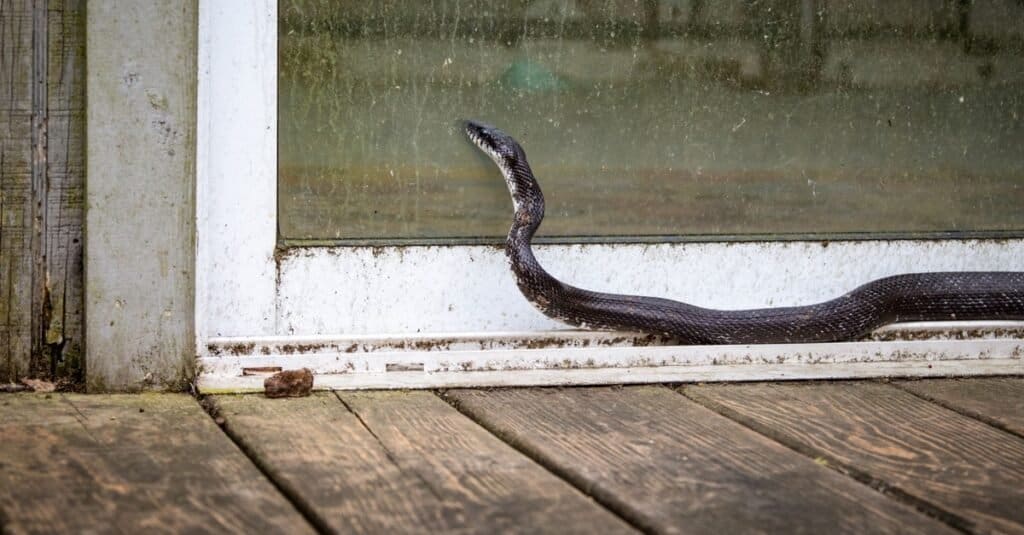
Rat snakes are excellent pest exterminators among the snakes in North Carolina.
©Kyla Metzker/Shutterstock.com
Rat snakes are the pest exterminators among the snakes in North Carolina. They like living up in the mountains and far down in the Coastal Plains. The rat snakes in the mountains look scary because they are almost entirely black, but they are very shy and will speed away from people rather than hang around if anyone comes near them. Rat snakes that live down in the plains will have a more olive color that makes it easier for them to blend in with their surroundings.
Fear not if you see a rat snake, as they are non-venomous. In fact, rat snakes are very helpful to people because they primarily eat rodents and pests.
Ring-Necked Snake (Diadophis punctatus)
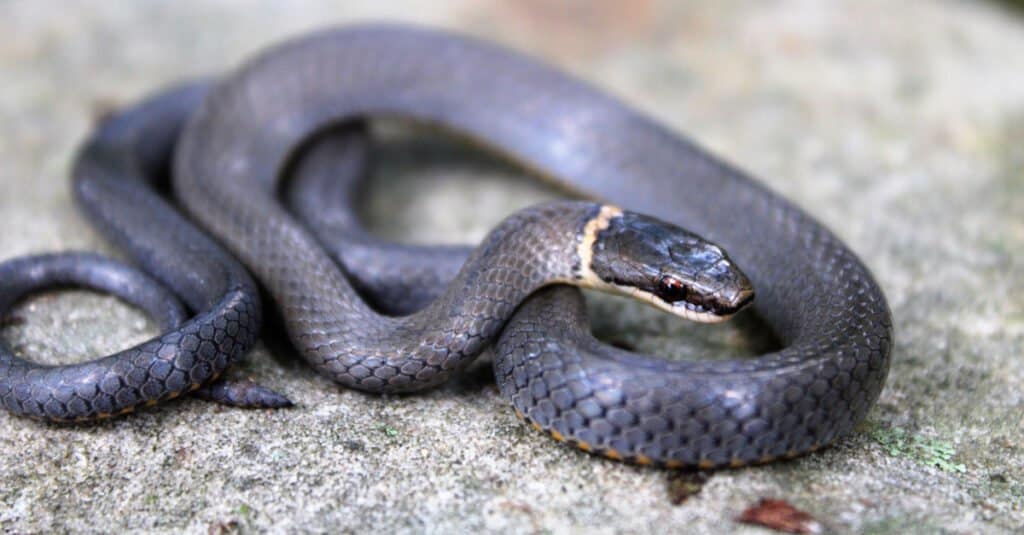
Ring-necked snakes are easily identifiable thanks to the coloration near their head.
©Tucker Heptinstall/Shutterstock.com
It’s easy to recognize a ring-necked snake. They are usually brown or olive, and sometimes they have an almost black base color but they will also have a red, orange, or yellow ring around their necks that matches their belly color.
Ring-necked snakes live all throughout the state of North Carolina. Their coloring changes depending on where in the state they are living, and ring-necked snakes that are coastal dwellers may not have a full ring around their necks. Homeowners and suburban dwellers may find ring-necked snakes living in their mulch, under flowerbeds or vegetable gardens, under planters, or under piles of leaves or grass clippings. The species is small, generally measuring just 10 to 15 inches, and is non-venomous.
Rainbow Snake (Farancia erytrogramma)
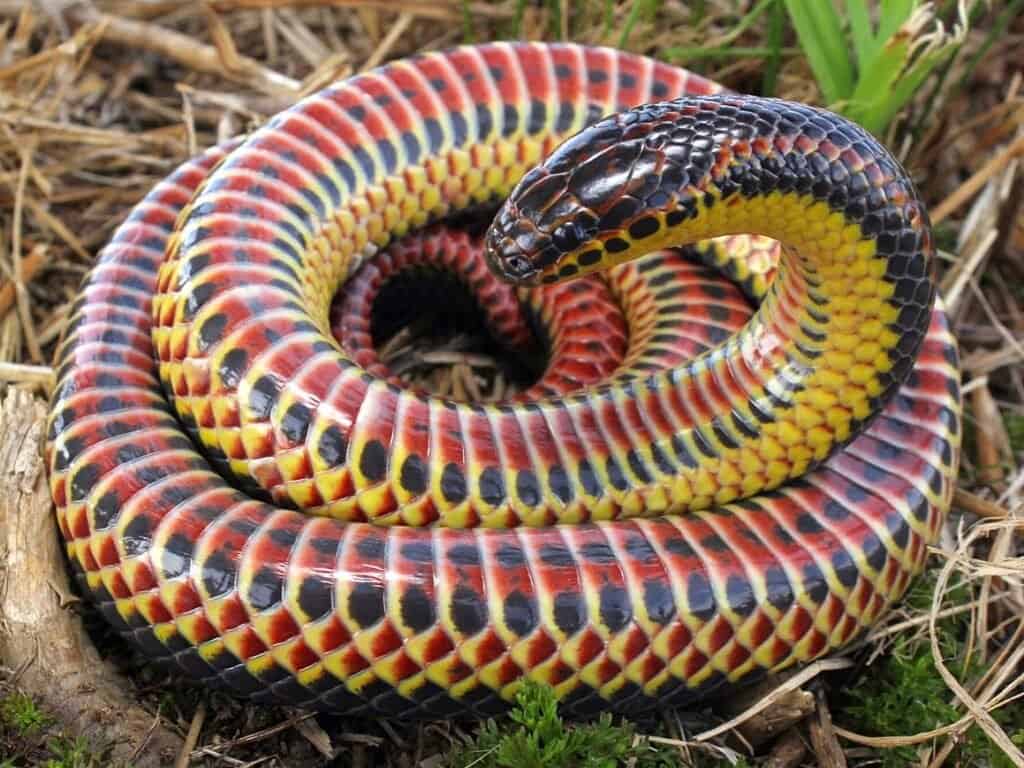
The rainbow snake is one of the prettiest to be found in North Carolina.
©Charles Baker / CC BY-SA 4.0 – License
You can’t miss a rainbow snake so you don’t have to worry about surprising this beauty! One of the prettiest NC snakes, rainbow snakes are unique because of their bright colors and bold geometric patterns. Typically rainbow snakes have a black base color with three long narrow red stripes running down the entire length of the back.
They may have yellow or cream bellies and some will also have yellow markings in addition to the red stripes. These snakes are semi-aquatic which means they like to be in or near water. They inhabit the southeastern Coastal Plains in North Carolina and live mostly in the swamps or near brackish rivers. They generally measure 3 to 5 feet in length when fully grown.
Carolina Swamp Snake or Black Swamp Snake (Liodytes pygaea)

Carolina swamp snakes prefer being in the water to on land and avoid humans.
©iStock.com/passion4nature
Snakes in North Carolina include swamp snakes among their numbers. They don’t like people and don’t even like to be on the land that much! They are mostly aquatic and like to stay in shallow water that has a lot of vegetation where they can hide. You may see one of these stunning snakes when you are kayaking or boating in the shallows and swamps. The top of the snake is black or dark olive to make it easier for it to blend into vegetation, but the snake’s belly is a bright scarlet red.
They are small and if they do leave the safety of their vegetative cover they only do it at night unless they are startled out of a hiding place. Like many snakes, the Carolina swamp snake is known by a number of names and also may be called the black swamp snake. They are generally less than 2 feet long and can be very abundant in wetlands. Swamp snakes are only found in the Tidewater region along the coast.
Northern Water Snake (Nerodia sipedon)
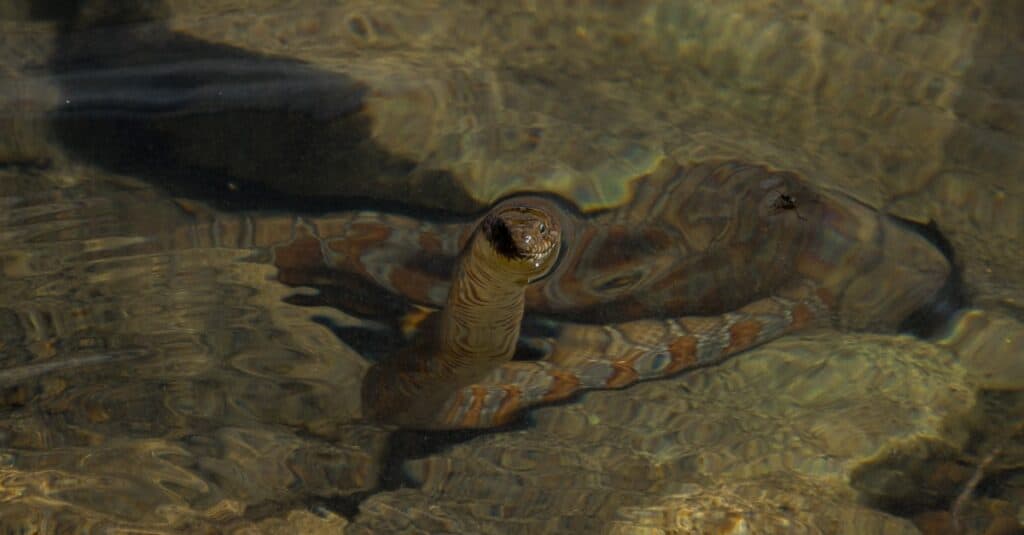
The northern water snake reaches up to 4.5 feet in length.
©iStock.com/manuellacoste
There are four different aquatic snakes (water snakes) that live in North Carolina, and one of them is the northern water snake. The northern water snake lives in ponds and in some of the streams throughout most of the state except in the Coastal Plains in the southern half of North Carolina. Northern water snakes have a light tan or light brown body and have dark red, red-orange, or dark brown markings. One thing that you should know is that northern water snakes can be aggressive.
They are not venomous, so a bite from one of these snakes won’t seriously injure you. But they can give you a nasty surprise if you are not paying attention when you are fishing, boating, or kayaking in the ponds and rivers in North Carolina. The northern water snake is often confused with the cottonmouth (water moccasin). If you’re confused about the apparent differences between the two, make sure to read our full guide comparing water snakes and cottonmouths.
Venomous Snakes in North Carolina
North Carolina has more venomous snakes than many other states. Snake bite cases begin rising in the spring, with about 85 cases of venomous snake bites in May, on average. Just remember if you’re bitten by a venomous snake only 1 in 500 bites prove fatal. If you learn to identify snakes that are venomous and seek immediate medical attention, the risk from snake venomous snake bites drops dramatically.
The following six venomous snakes can all be found in North Carolina:
- Copperhead
- Cottonmouth
- Eastern coral snake
- Pygmy rattlesnake
- Eastern diamondback rattlesnake
- Timber rattlesnake.
We’ll detail some of them below, starting with one of the most common venomous snakes in North Carolina, the copperhead.
Copperhead Snake (Agkistrodon contortrix)
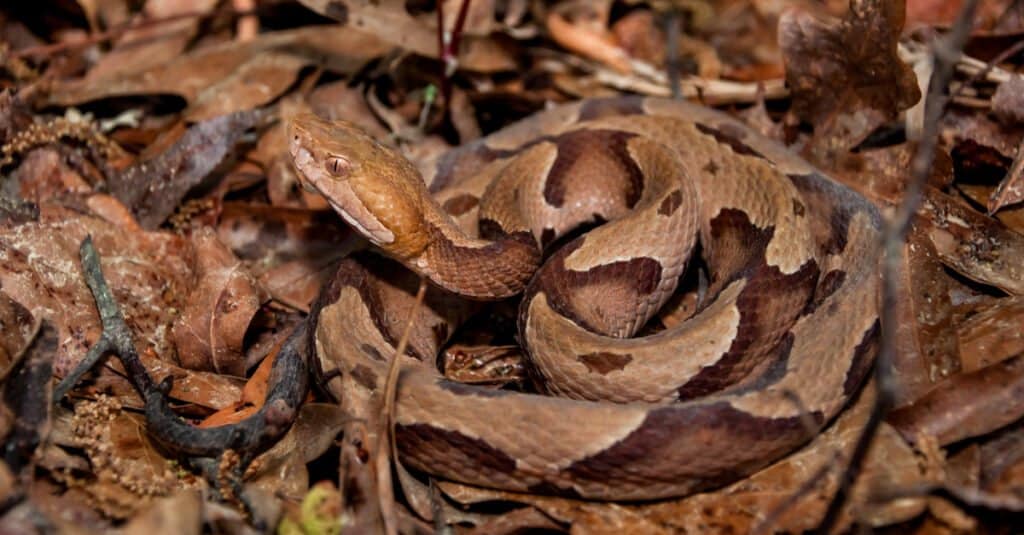
Copperheads are the most common venomous snakes in North Carolina.
©Jay Ondreicka/Shutterstock.com
Copperhead snakes are the most common venomous snakes in North Carolina. They are found in all parts of the state. 90% of venomous snake bites in North Carolina each year are from copperhead snakes. These snakes have color patterns that vary from light tan to gray and they have dark markings that run the length of their bodies that are in an hourglass pattern. They’re fairly short and usually fall somewhere between 2-4 feet long. But, they can camouflage themselves very well. While copperhead snakes lack a rattle, they will shake their tails as a warning. In addition, they will generally raise their heads as a warning before striking.
Cottonmouth Snake (Agkistrodon piscivorus)
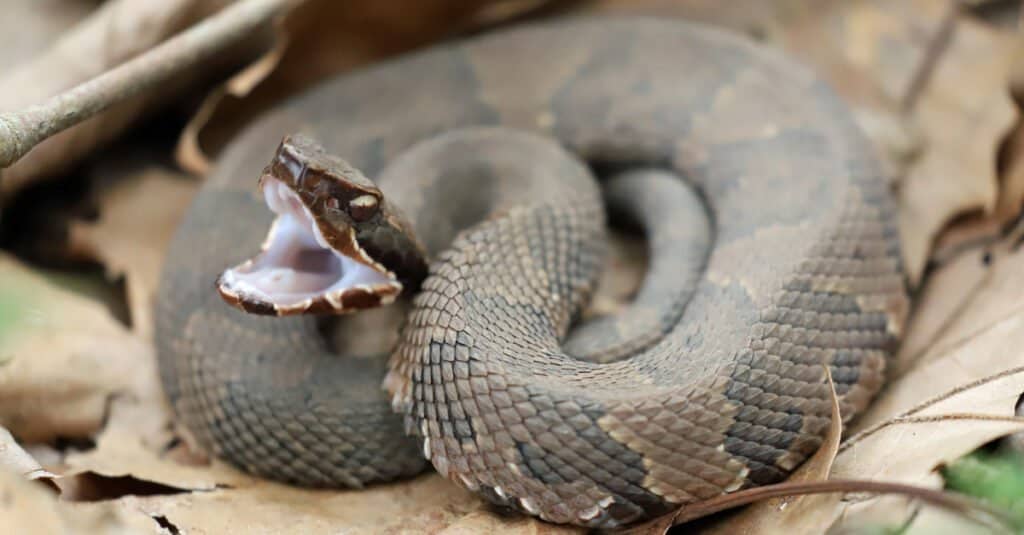
The cottonmouth’s name refers to its large off-white mouth.
©KF2017/Shutterstock.com
The cottonmouth is another very common snake in some parts of North Carolina. It’s sometimes called the water moccasin, so locals may call it a water moccasin instead of a cottonmouth. This snake prefers the water and its main habitat in North Carolina is in the Coastal Plains and in the Outer Banks. You may see one of these snakes in the water or near the water. Cottonmouth snakes are mostly black, like many other snakes, but when they open their jaws wide they expose a large off-white mouth. That’s where the name “cottonmouth” comes from.
Timber Rattlesnake (Crotalus horridus)
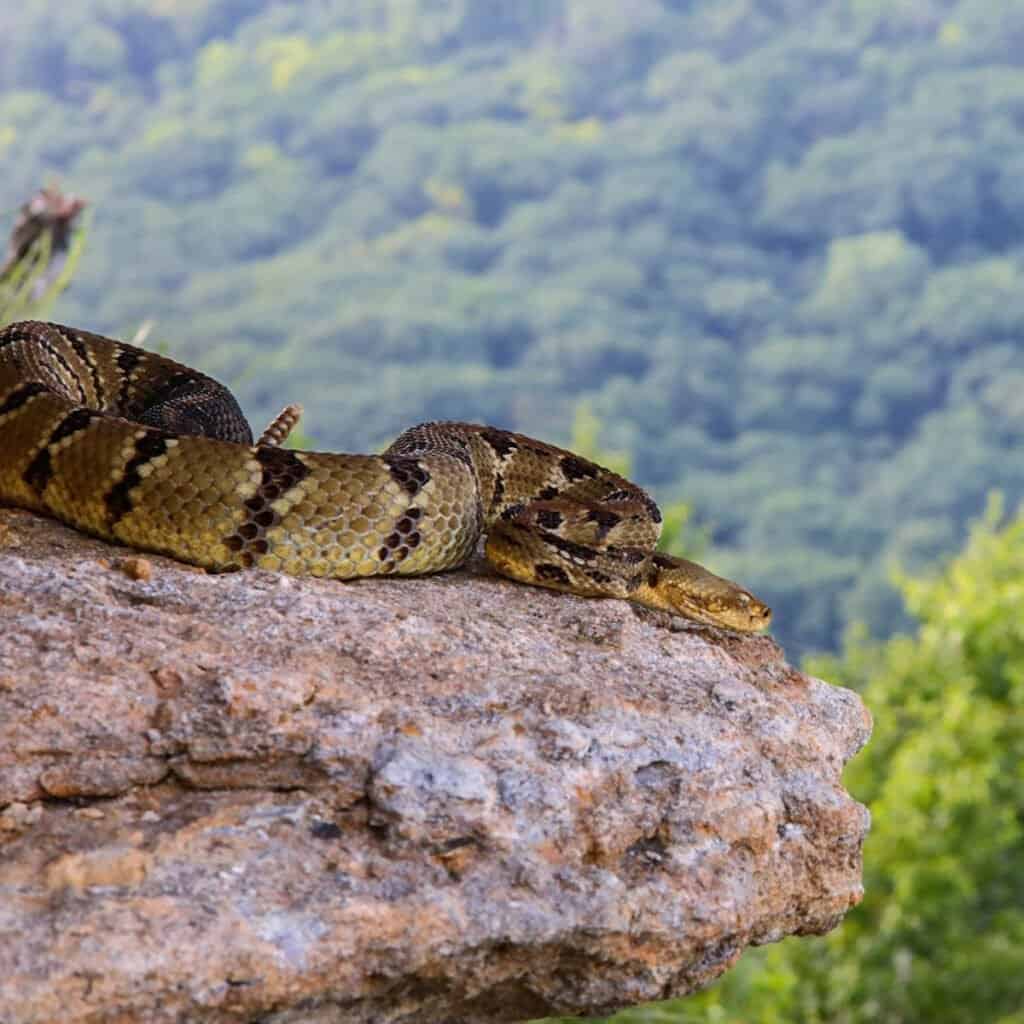
Timber rattlesnakes are especially common in the mountains and foothills of western North Carolina.
©bradenjalexander/Shutterstock.com
NC snakes such as the timber rattlesnake live primarily high up in the mountains. But there are some living in the Coastal Plains and parts of Piedmont, too. Timber rattlesnakes are about four to five feet long and the snakes that live in the mountains have colors that help them blend into the local environment. They are gray, brown, and black with dark markings that help them conceal themselves in the foliage and trees.
Pygmy Rattlesnake (Sistrurus miliarius)
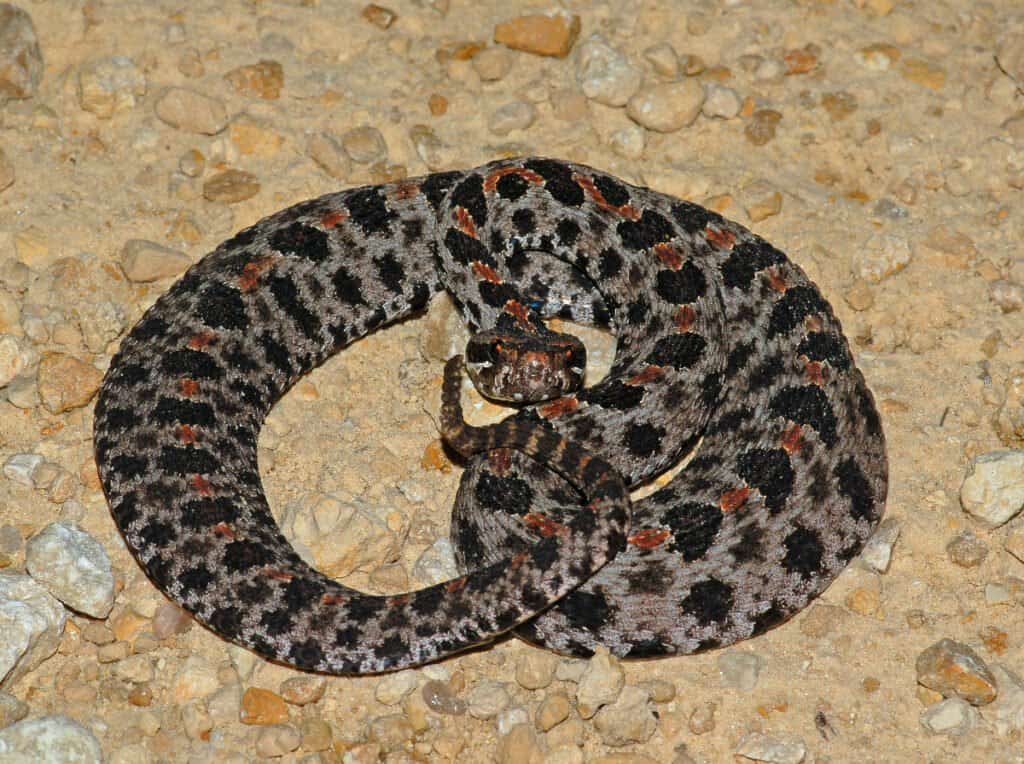
Pygmy rattlesnakes prefer to rely on their coloring to camouflage them.
©Gerald A. DeBoer/Shutterstock.com
Pygmy rattlesnakes are small but also a scary sight! They are tiny compared to other rattlesnakes. They’re just about 12 to 24 inches long. In South Carolina, they are usually light gray with dark gray or black large patches on their backs. And even though they are venomous they will try to avoid any kind of confrontation. Pygmy rattlesnakes prefer to rely on their coloring to camouflage them. However, don’t be fooled by their small size. They can and will bite when threatened or if you try to handle them. In North Carolina, pygmy rattlesnakes live close to metro areas. They can be found in Crowder’s Mountain State Park near Charlotte, for example, and in some counties in the Coastal Plains.
Summary of Snakes in North Carolina
Here’s a recap of the venomous and common non-venomous snakes we took a detailed look at:
| Number | Snake | Type |
|---|---|---|
| 1 | Rat Snake | Non-Venomous |
| 2 | Ring-Necked Snake | Non-Venomous |
| 3 | Rainbow Snake | Non-Venomous |
| 4 | Carolina Swamp Snake (Black Swamp Snake) | Non-Venomous |
| 5 | Northern Water Snake | Non-Venomous |
| 6 | Copperhead Snake | Venomous |
| 7 | Cottonmouth Snake | Venomous |
| 8 | Timber Rattlesnake | Venomous |
| 9 | Pygmy Rattlesnake | Venomous |
| 10 | Eastern Coral Snake | Venomous |
| 11 | Diamondback Rattlesnake | Venomous |
A Complete List of the 37 Snakes in North Carolina
There are a lot of snakes in North Carolina, including one of the largest varieties of rattlesnakes in any state in the country. It doesn’t matter if you live in North Carolina or you are visiting to enjoy some of the fantastic weather and beautiful landscape. You should watch out for snakes and always move very carefully when you’re out hiking, walking, fishing, or enjoying outdoor sports. A complete list of all the 37 types of snakes in North Carolina:
- Worm Snake
- Scarlet Snake
- Ring-necked Snake
- Rat Snake
- Mud Snake
- Rainbow Snake
- Queen Snake
- Eastern Hognose
- Southern Hognose
- Mole Kingsnake
- Eastern Kingsnake
- Scarlet Kingsnake
- Eastern Milk Snake
- Coach Whipe Snake
- Red-bellied Water Snake
- Banded Water Snake
- Northern Water Snake
- Brown Water Snake
- Rough Green Snake
- Black Racer
- Pine Snake
- Glossy Crayfish Snake
- Corn Snake
- Pine Woods Snake
- Carolina Swamp Sanke
- Brown Snake
- Red-bellied Snake
- Crowned Snake
- Ribbon Snake
- Eastern Garter Snake
- Rough Earth Snake
- Smooth Earth Snake
- Copperhead
- Cottonmouth
- Diamondback Rattlesnake
- Pygmy Rattlesnake
- Timber Rattlesnake
- Eastern Coral Snake.
Which U.S. State Has the Most Snake Bites?
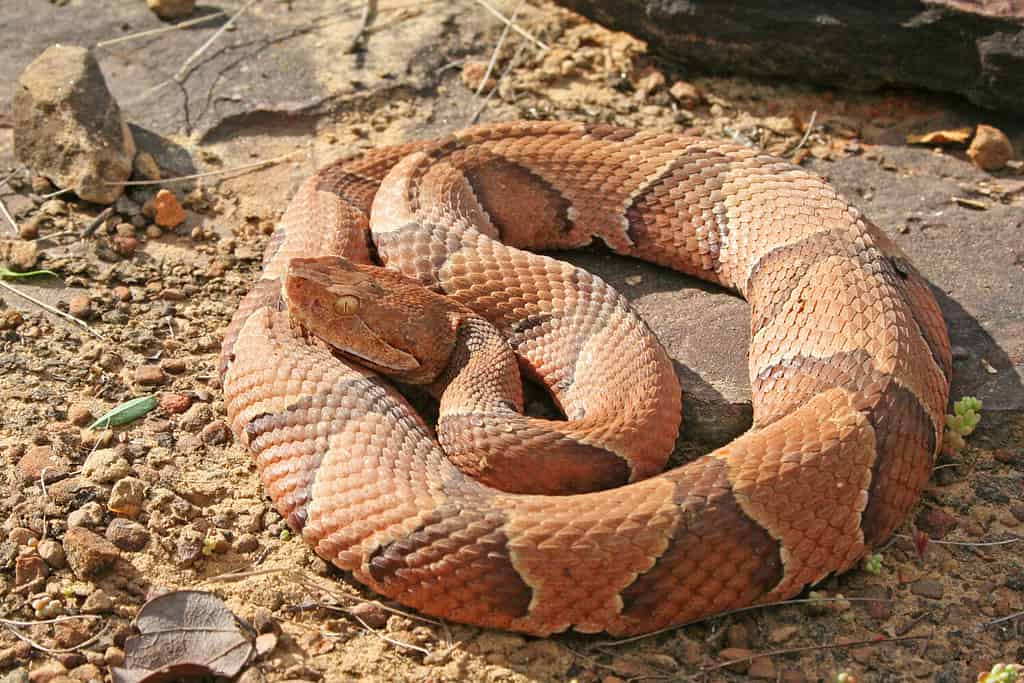
The venomous copperhead is among those responsible for snake bites in North Carolina.
©Creeping Things/Shutterstock.com
We’ve taken a closer look at numerous snake species slithering about in North Carolina. So which state ranks the highest in snake bites? That would actually be North Carolina! The snake bite rate in this southeastern state is 157.8 bites per million population annually. As the population as of 2021 was a little over 10 million (10.55 to be exact), and we were to just figure it off of 10 million, that would average out to roughly 1,580 reported snake bites per year. In the year 2019, there were 92 people bitten by venomous snakes in North Carolina.
The top 6 states for reported snake bites are:
| Rank | State | Bites per Million |
|---|---|---|
| 1 | North Carolina | 157.8 |
| 2 | West Virginia | 105.3 |
| 3 | Arkansas | 92.9 |
| 4 | Oklahoma | 61 |
| 5 | Virginia | 48.7 |
| 6 | Texas | 44.2 |
The photo featured at the top of this post is © Scott Delony/Shutterstock.com
Discover the "Monster" Snake 5X Bigger than an Anaconda
Every day A-Z Animals sends out some of the most incredible facts in the world from our free newsletter. Want to discover the 10 most beautiful snakes in the world, a "snake island" where you're never more than 3 feet from danger, or a "monster" snake 5X larger than an anaconda? Then sign up right now and you'll start receiving our daily newsletter absolutely free.
FAQs (Frequently Asked Questions)
What kind of snakes are in North Carolina?
There are 37 different species of snakes that can be found in North Carolina. The majority are harmless and non-venomous, but the state does have six venomous species.
When do snakes come out of hibernation in North Carolina?
Snakes begin emerging throughout March and April. When snakes emerge depends on the part of the state. Since snakes don’t hibernate the same way mammals do (they bruminate), they can be active earlier if temperatures increase unseasonally.
How many water snakes live in North Carolina?
There are four snakes that are “water snakes” in North Carolina. They are the northern water snake, the banded water snake, the red-bellied water snake, and the brown water snake. While these are the four “true” water snakes, there are a number of other species that spend much of their time in aquatic environments. For example, Carolina swamp snakes can be especially common in wetlands along the coast.
What black snakes live in North Carolina?
There are a number of black snakes in North Carolina, but the rat snake is most commonly called the “black snake.” They can grow quite large (up to 6 feet in length) but are non-venomous.
What snakes are most common in North Carolina?
The most common venomous snake in North Carolina is the copperhead. 90% of venomous (poisonous) snake bites in the state come from copperheads. The most common non-venomous snake is the worm snake, which is harmless.
What types of poisonous snakes live in North Carolina?
There are six poisonous (venomous) snakes that live in North Carolina. There are the copperhead, timber rattlesnake, cottonmouth, pygmy rattlesnake, diamondback rattlesnake, and the eastern coral snake.
What are the largest snakes near Charlotte, North Carolina?
The 5 largest snakes near Charlotte are the eastern kingsnake, timber rattlesnake, northern water snake, black racer and the eastern rat snake.
Thank you for reading! Have some feedback for us? Contact the AZ Animals editorial team.






